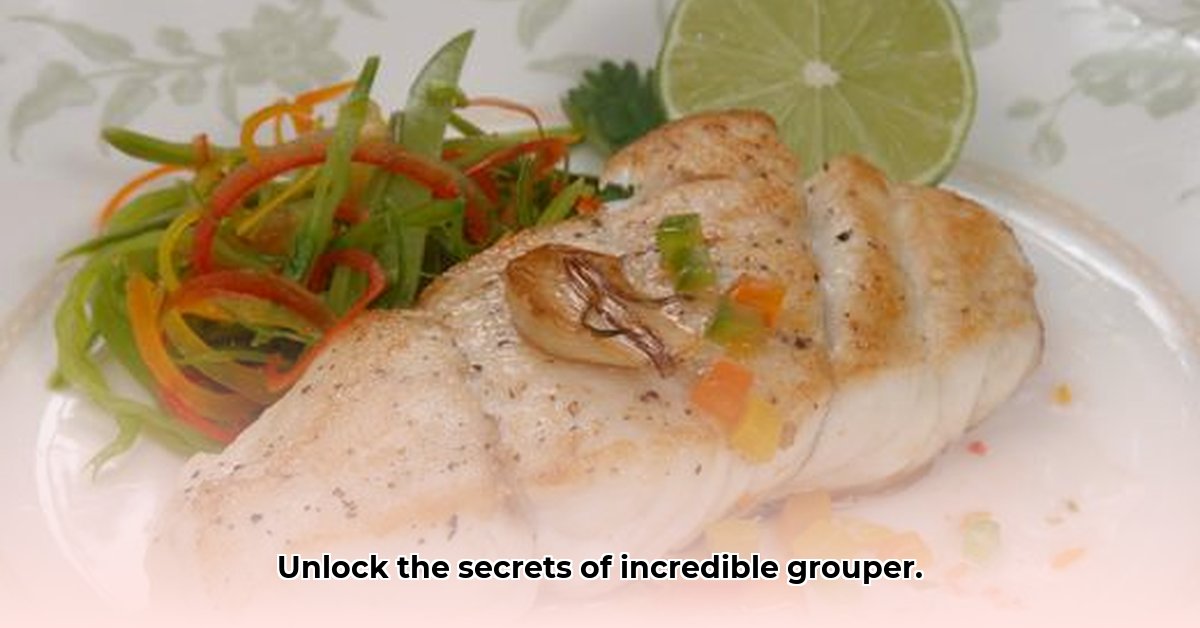Grouper: It’s a delicious fish, but there’s more to it than just amazing flavor. This guide will walk you through everything you need to know about this popular seafood, from the subtle sweetness of its flesh to the different types you can find, and importantly, how to make sure your meal is safe and delicious. We’ll cover cooking methods, give you tips on buying the best grouper, and explain a serious risk – ciguatera poisoning – and how to avoid it. Get ready to learn how to cook incredible grouper dishes, confidently and safely!
Grouper Taste: A Deep Dive into Flavor, Cooking, and Safety
Let’s talk grouper! This impressive fish offers a delightful culinary experience, but understanding its flavor nuances and safety aspects is key to enjoying it responsibly. Think of it like choosing a wine – there are subtle differences that significantly impact the overall experience. What factors influence grouper’s unique flavor profile, and why is sourcing so crucial?
Decoding the Delicate Flavor Profile of Grouper
What does grouper taste like? Most people describe it as mild, slightly sweet, and refreshingly delicate. The texture is usually firm and flaky, with a moistness that makes it incredibly pleasing to eat. However, this is just a starting point. Different grouper species have unique flavor profiles, influenced by their habitat, diet, and even the time of year they’re caught. Understanding these nuances can elevate your dining experience.
For example, red grouper, a popular choice constituting about 70% of the US grouper harvest, often boasts a slightly sweeter taste than its black grouper cousin. Black grouper, on the other hand, can have a more earthy and robust flavor and yields more edible fish content. Gag grouper usually falls somewhere in the middle, offering a balanced flavor and texture profile. It’s kind of like comparing different apple varieties: each has its own distinct characteristics. The flavor can even vary depending on where the grouper was caught! This makes every grouper a potential culinary adventure. The taste differences between species can be subtle, but they make a difference. Grouper offers a culinary adventure with every catch. How can you distinguish between the subtle taste variations of different grouper species?
Exploring the Diverse World of Grouper Species
Red grouper might be the star of many fish counters, but the world of grouper is incredibly diverse. Beyond the common red, black, and gag varieties, you’ll find a whole host of less-familiar species, each with its own unique taste and texture. Consider yellow edge grouper (known for a slightly more potent, yet still mild, flavor), giant grouper (though rarely eaten due to mercury concerns), snowy grouper (milder taste that blends well with most recipes), scamp grouper (easy to cook and clean, low mercury risk), and coney grouper (small, with a slightly sharper taste) – each offers a slightly different culinary experience. Have you ever tried one of the less common varieties? You might be surprised by the taste! There’s still much to discover about the diverse world of grouper flavors. In the quest for culinary excellence, is the exploration of less common grouper species justified by their unique flavor profiles, despite potential sourcing challenges?
Mastering the Art of Cooking Grouper: Techniques and Tips
Proper cooking is essential for unlocking grouper’s full potential. Overcooking, however, is a common mistake that can result in dry, tough fish. The good news is grouper is more forgiving than other white fish due to its high oil and moisture content. Here are some tips for achieving perfectly cooked grouper, regardless of your chosen method: Remember, grouper cooks quickly, and it’s better to slightly undercook it than overcook it.
Grilling Grouper:
- Marinate: Start by marinating your grouper fillets for 15-20 minutes in a zesty citrus marinade. A mixture of lemon juice, olive oil, garlic, and herbs works wonders. This adds flavor and keeps the fish moist.
- Sear: Sear the fillets over medium-high heat, creating a beautiful, slightly charred crust while keeping the inside tender.
- Cook to Perfection: Cook until the internal temperature reaches 145°F (63°C). This ensures the fish is cooked through without becoming dry.
Baking Grouper:
- Season: Season the grouper fillets simply with salt, pepper, and your favorite herbs. Consider adding a touch of garlic powder, paprika, or Old Bay seasoning for extra flavor.
- Bake: Bake at 375°F (190°C) for about 12-15 minutes, or until the fish is opaque and flakes easily with a fork.
- Brighten the Flavor: A squeeze of fresh lemon juice brightens the flavor and adds a touch of acidity.
Pan-Frying Grouper:
- Coat: Lightly coat the grouper fillets in seasoned flour. A mix of flour, salt, pepper, and a pinch of cayenne pepper creates a flavorful crust.
- Fry: Fry in hot oil until golden brown and cooked through. Be careful not to overcrowd the pan, which can lower the oil temperature and result in soggy fish.
- Drain: Drain the excess oil on paper towels before serving.
Broiling Grouper:
- Position: Place the fillets about 4 inches from the heat source.
- Broil: Broil for 3-5 minutes per side, keeping a close eye to prevent burning.
- Enjoy: The broiling method creates a flavorful, slightly charred surface.
Blackening Grouper:
- Prepare the Blackening Spice: Combine paprika, cayenne pepper, garlic powder, onion powder, thyme, oregano, salt, and pepper.
- Coat the fish: Brush the grouper fillets with melted butter, then dredge in the blackening spice mixture, ensuring an even coating.
- Cook: Cook in a hot skillet until a dark crust forms.
Regardless of the method, remember that grouper cooks quickly. It’s better to slightly undercook it than overcook it. Could mastering these diverse cooking methods for grouper provide a heightened culinary experience, or is simplicity key to preserving the fish’s inherent flavors?
Navigating the Ciguatera Conundrum: Safety First!
Now, let’s address an important safety concern: ciguatera poisoning. While incredibly delicious, some grouper can contain ciguatera toxins. These toxins are produced by dinoflagellates and accumulate in reef fish like grouper. These toxins are not destroyed by cooking, so it’s crucial to prioritize safety measures. The risk of ciguatera is linked to the grouper’s diet and the location where it was caught. Areas like the Caribbean Sea, Hawaii, and parts of Central America are often associated with a higher risk of ciguatera.
Minimizing Your Risk:
- Buy from Reputable Sources: Purchase grouper only from reputable fishmongers or supermarkets known for their sustainable and ethical sourcing practices. Local fish markets are generally a safer bet compared to large chains.
- Ask Questions: Don’t hesitate to ask about the grouper’s origin. Knowing where the fish was caught is crucial.
- Avoid High-Risk Zones: Steer clear of grouper caught in known high-risk areas.
Given that ciguatera toxins are not eliminated through cooking, how can consumers confidently ascertain the safety of grouper purchased from various sources?
Sourcing Sustainable Grouper: Making Ethical Choices
Choosing your grouper wisely is as important as selecting a good recipe. Look for sustainable certifications from organizations like the Marine Stewardship Council (MSC) and choose fishmongers who prioritize responsible fishing practices. By making informed and conscious choices, you’re contributing to the health of our oceans while ensuring you’re enjoying safe and delicious grouper. In light of the potential risks associated with grouper consumption, what role do sustainable certifications play in ensuring both consumer safety and the long-term health of our marine ecosystems?
Delicious Grouper Recipes
Grilled Grouper with Lemon-Herb Marinade
Ingredients:
- 1.5 lbs grouper fillets
- 1/4 cup olive oil
- 1/4 cup lemon juice
- 2 cloves garlic, minced
- 1 tbsp fresh herbs (thyme, rosemary, oregano), chopped
- Salt and pepper to taste
Instructions:
- In a bowl, whisk together olive oil, lemon juice, garlic, herbs, salt, and pepper.
- Marinate grouper fillets in the mixture for 15-20 minutes.
- Preheat grill to medium-high heat.
- Grill grouper for 3-5 minutes per side, or until cooked through.
- Serve immediately.
Pan-Seared Grouper with Garlic Butter Sauce
Ingredients:
- 1.5 lbs grouper fillets
- 2 tbsp olive oil
- 4 tbsp butter
- 4 cloves garlic, minced
- 1/4 cup white wine (optional)
- 2 tbsp fresh parsley, chopped
- Salt and pepper to taste
Instructions:
- Season grouper fillets with salt and pepper.
- Heat olive oil in a large skillet over medium-high heat.
- Sear grouper for 3-4 minutes per side, or until golden brown and cooked through. Remove from skillet and
- Unlock Young Doctors’ Work-Life Balance: Actionable Strategies Now - December 2, 2025
- Unlock Life Harmony: Work-Life Integration Guide - November 30, 2025
- Unlock Work-Life Harmony:Your Guide to Integration - November 27, 2025
















